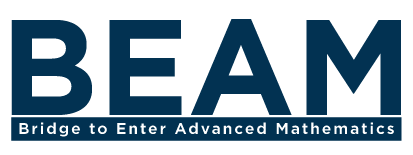This winter, BEAM is busy! We are busy hiring summer faculty, summer counselors, and other summer staff and even a few full time staff. But those aren’t the only positions we are looking to fill. Every summer we invite guest speakers to BEAM Summer Away and BEAM Discovery sites. Our invited speakers are talented mathematicians from around the world, and their talks are a window into the work of professional mathematicians, giving students an opportunity to learn new ideas from the wide world of mathematics. Some past speakers have focused on complex mathematical topics, while others share their day to day life as career mathematicians. As we line up further intriguing talks for this summer, now is a great moment to reflect on some of the lovely talks and mind-bending math our guest speakers shared with us last summer.
This past summer our guests included Dr. Edray H. Goins, Dr. Susan Loepp, Tai-Danae Bradley, and Darleen Perez-Lavin. They each presented a unique take on a mathematical topic and BEAM students got a kick out of what they had to share.
Edray confronted a complicated topic: infinities and cardinality. Though this topic is deep and challenging even for mathematics majors at top colleges and universities, Edray balanced the abstract ideas with concrete examples. He started with basic ideas and questions: What is a set? How can you count things in a set? How many subsets are there in a set with n elements? Then the talk got more abstract, and Edray lead students through a very enjoyable explanation of Cantor's famous theorem. Students had the chance to see how much there is to the mathematical world than just numbers, equations and geometry formulas.
BEAM values having guest talks that start out very friendly to students and then go off the deep end in mathematics a bit because they allow students to see just how serious and deep math can be!
Dr. Edray H. Goins is a Professor of Mathematics at Pomona College in Claremont, CA and president of the National Association of Mathematicians. Edray presented at BEAM Discovery Los Angeles.
Dr. Goins presents to the students at BEAM Summer Away during Vassar 2016. Edray has been a guest speaker at BEAM for three straight summers!
Dr. Susan Loepp, Chair and Professor of Mathematics, Williams College. Susan presented at BEAM Summer Away at Union College.
Susan introduced a team game that involved wearing hats. It costs money to play, but if you win, you get the cost doubled back. Will you win or lose money in the long run? Susan gave student volunteers a chance to play the game (not with real money) and think about optimal strategies. After a lot of trial and error (and some inadvertent cheating), students claimed to Susan that they could win 50% of the time. But she said they could do better! The rest of the talk focused on independent and dependent probability and how those concepts impact game theory. Students found the session fun and silly, yet thought provoking. Many were still talking about it the next day!
Tai-Danae came into the room with lots of brightly colored cubes. The purpose? The Instant Insanity puzzle. Everyone got four cubes with each face colored in one of four different colors. The question: can you make a stack four cubes tall so that each side of the stack has one face of each color? With over 80,000 possible configurations, this is a big challenge, but using the tools of graph theory you can solve it quickly! If you're curious, Tai-Danae also presented it on PBS Infinite Series and you can take a look and try it yourself.
Tai-Danae Bradley is a PhD candidate in mathematics at the CUNY Graduate Center, and creator of the intriguing math blog: https://www.math3ma.com/. Tai-Danae presented at BEAM Discovery NYC Uptown.
Darleen Perez-Lavin is a SMART fellow and graduate student at the University of Kentucky. Her talk was based on quantum computing research at Fermi National Accelerator Laboratory. Darleen presented at BEAM Summer Away at Union College.
Darleen gave a presentation on the Traveling Circus Problem, a more general version of the well-known and very difficult Traveling Salesman Problem (so well known and difficult that the University of Waterloo has a whole website devoted to it). Darleen presented new research on how this problem is related to quantum physics. Her talk gave a glimpse into how pure mathematics can have applied applications. The ideas jumped from Euler's solution to the Seven Bridges of Königsberg problem to talking about modern physics! Students interested in applied mathematics were especially fascinated.
We can’t wait to see all the amazing talks that this upcoming summer has in store. And if you enjoy cool math (and aren’t quite as busy as BEAM is at the moment), we encourage you explore the topics touched on in the talks above.
BEAM students play a game during Dr. Susan Loepp’s math talk at BEAM 2018.












